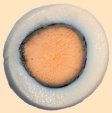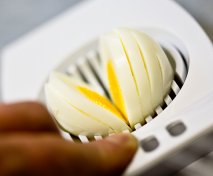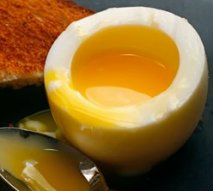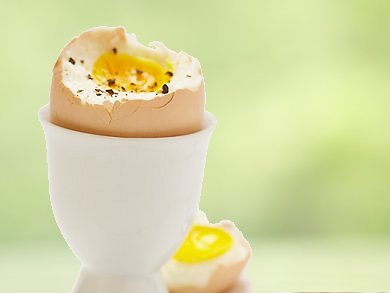In many parts of the world, a freshly boiled (usually soft-boiled) egg is the crowning touch to every breakfast table, and is the very embodiment of a good start to the day. When we rap a knife on the white or brown shell of such an egg we are seldom conscious of what a technical marvel we are dealing with. Under that unpretentious eggshell (which in itself is a structural masterpiece!) is concealed, in the narrowest of spaces, a fully-fledged culinary delicacy, one that we have looked at very closely. Now for the practical part.
>8. An Ideal Egg, from a Culinary Perspective
We at last attempt to translate our newly-won insights into practice.
When it comes to egg cookery, the biggest technical problem is that too often, part of the egg white escapes through a crack in the shell, presumably as a consequence of increasing air pressure in the air sac. The most effective antidote is generally thought to be provided by an egg piercer, with which a tiny hole can be made in the shell, specifically at the blunt end of the egg. As the egg is heated, air bubbles escape through such a hole, which would appear to be corroborating evidence for our assumption.
Wrong! Theodore F. Irmiter and his colleagues in 1970 conducted an extensive set of investigations [29] through which they showed that piercing the shell actually increases the probability (by a factor of 10!) that an egg will crack under these circumstances. So, hands off the egg piercer! Apparently the most plausible cause of egg cracking on the domestic stove is instead, too vigorous boiling, with the accompanying dashing of eggs against the bottom of the pan and/or collisions with one another.
The professionals therefore suspend their eggs in simmering water, in a single layer, in a colander.
Other points to remember when cooking an egg are:
- As far as shell cracking is concerned, it makes no difference whatsoever, for example, whether eggs come directly from the refrigerator, or are already at room temperature.
- Starting the cooking process with eggs in water that is cold causes cracks to develop twice as often as when they are instead introduced into boiling water!
- It is especially difficult to remove the shell from a boiled egg that is very fresh, because with such an egg the shell is still tightly bound to the shell membrane. As an egg ages, its pH increases, and the membrane begins to come loose. Hard-boiled eggs are shelled most easily if the pH in the white has reached 8.9 or above.
- Iron sulfide formation is commonly observed in hard-boiled eggs, taking the form of an unappealing blue-green coloration of the yolk (Fig. 20). This is most often the case with eggs that have been boiled for too long. Ring formation can be minimized by using fresh eggs, limiting the boiling time, and quenching immediately in cold water.

Figure 20. Typical greenish-black ring at the interface between the white and the yolk of an egg.
We leave it to the reader to analyze individual eggs in terms of anticipated thermal-conductivity behavior. Caution is advised, however, since Eqns. (2)–(5) (as shown in Part 2) are only approximations, based on drastic simplifications: A hen’s egg is, after all, not a sphere, and is most certainly not homogeneous.
The ideal soft-boiled egg in a culinary sense—and that, after all, is what we are most interested in—would have a viscous yolk, surrounded by a white that is firm, but not tough. This is a difficult state to achieve with water at 95–100 °C, because the outermost layer of white rapidly reaches a temperature > 90 °C, remaining there throughout the process, which means it will necessarily become rather hard.
An interesting physical and culinary alternative would be “cooking” an egg in warm water, maintained at 65–70 °C. Unfortunately, the results are disappointing: After an hour in 65 °C water one sadly obtains an egg with a half-solidified, but not entirely solid yolk, and a white that is still runny. Such eggs have been called “opposite-boiled” [30], and they have understandably failed to gain wide acceptance.
The remarkable coagulation behavior just described in fact contradicts many reports in the literature, in which egg white always coagulates at lower temperatures than egg yolk does. Apparently, between eggshell and yolk there are so many protein phenomena taking place that it is still not possible to take stock of them scientifically in their totality. We are thus left with only empiricism; fortunately, however, generations of chefs—in restaurants as well as at countless stoves in their kitchens at home—have devised a myriad of egg recipes that can serve to orient the practicing scientist. We begin here with a bow to the grande cuisine of France, presenting three original recipes from Paul Bocuse [31], perhaps the most famous of contemporary chefs. These recipes reveal that even Bocuse has no real, secret tricks up his sleeve, apart from the fact that he repeatedly insists upon use of the freshest eggs possible. But watch out: All times specified below refer to eggs initially at room temperature.
Hard-Boiled Eggs (Oeufs durs)
Bring saltwater to the boil, using a pot sufficiently large for the quantity of eggs to be prepared. Lay the eggs in a colander, or in a strainer with large openings, and then lower the assembly carefully into the boiling water. Starting from the moment that boiling resumes. Medium-sized eggs should be left in for 9 minutes, large eggs for 10 minutes. Finally, lift the colander and eggs out of the boiling water and submerge immediately in cold water to facilitate subsequent shelling.
Be careful not to exceed the recommended times, as otherwise the egg whites will become tough, and the yolks will be too dry.
Soft, “Waxy” Eggs (Oeufs mollets, a classic French variant on soft-boiled eggs)
Soft, waxy eggs are prepared similarly to hard-boiled eggs. The eggs are again laid in a colander or a strainer with large holes, and then lowered into boiling saltwater. From the time boiling resumes, leave medium-sized eggs in for an additional 6 minutes of cooking. Colander and eggs are then lifted out, and quenched in cold water. Carefully shell the eggs and, if the plan is to serve them hot, keep them as necessary in warm saltwater.
The Refined Alternative: Oeufs pochés (Poached Eggs)
In the case of poaching, the eggshells must be broken open, with the contents introduced as carefully as possible into boiling, acidified water. Due to the absence of a shell, one can readily monitor in a detailed way all changes occurring in the egg’s consistency, especially with respect to the yolk.
For poaching purposes one should utilize a pan that is wide and not too deep. Fill it to the ¾-mark with water to which has been added one tablespoon of vinegar per quart (liter), and bring the water to a gentle boil. Crack an egg, and—directly over the water, at the point where the most bubbling is taking place—open the shell and carefully allow the egg to slip into the water such that the yolk does not break and the white forms a mantle surrounding it completely. Add, in the same manner, as many more eggs as required (but never more than 8), with the water continuing to simmer gently. The poaching process itself will not take more than 2½–3 minutes.
Lift out the eggs one at a time using a slotted spoon, pressing with your finger lightly on the yolks to make sure they are sufficiently done: All should be soft and flexible. Quickly transfer the eggs to cold water to prevent their cooking further. Next, lift them out of the cold water by hand, one at a time, trimming away any trailing filaments. Transfer the eggs into salted, lukewarm water if they are to be served hot, or to cold water if they will instead constitute elements of some larger, cold dish.
Grande cuisine recipes like these demonstrate how French chefs have long known what scientists have only recently managed to explain. For example, the legendary Auguste Escoffier noted long ago that only the freshest of eggs lead to satisfactory results upon poaching. Today we know why: Only if the tough white layer is still very viscous, will it readily form a compact, closed envelope of coagulated white around the yolk when placed in boiling water. On the other hand, with an egg that is too old, its thin runny white will separate, and thus thicken in an irregular way. As a result, the yolk will, to some extent, come loose, and in these places quickly become too hard. Here we see closure of the circle between the art of cooking and science: Chemistry in particular can bring to the culinary art valuable information about the extent to which traditions, perhaps passed down through many generations, are in fact rational.
In Summary …
Egg cookery is simultaneously an art and a science, wherein there is a constant striving for perfection, but no hope of ever actually achieving it. The amateur would-be chef is thus entirely justified in silencing the inevitable family carper by bellowing the categorical declaration: “Given a spatially inhomogeneous, linearly distorted ellipsoid—one securely encapsulated in a rigid casing fashioned from a complex protein-calcite composite, and in precisely the state in which it emerged from a common Gallus gallus domesticus—with such an ellipsoid, consisting moreover of an ensemble of globular gluco- and lipoprotein compartments, it is clearly quite impossible to maintain precise control over all the various denaturation phenomena as they play themselves out at compartment-boundary surfaces, based on manipulation exclusively of the twin variables time and temperature”. Upon the ensuing interval of stunned silence sure to be evoked by this outburst, one can then calmly assert that the prepared egg unveiled moments before has in fact turned out precisely as intended.
Period!
References
[29] T. F. Irmiter et al., Poultry Sci. 1970, 49, 1232. Https://doi.org/10.3382/ps.0491232
[30] E. Fooladi in www.fooducation.org
[31] P. Bocuse, Die Neue Küche, Econ Verlag, Düsseldorf, Germany, 1977.
(Bocuse’s recipes as presented here are virtually word-for-word identical to those of the great Auguste Escoffier in A. Escoffier, The Escoffier Cookbook, Crown Publishers, New York, USA, 1969).
Acknowledgements
I wish above all to express my deep appreciation to Dr. Hans Bauer and Bayer Schering Pharma AG, Berlin, Germany, for their support with respect to the nuclear spin tomographic study, which encompassed dozens of hen’s eggs. Dr. Waldemar Ternes of Hanover, Germany, provided me with gracious support as I was familiarizing myself initially with this difficult field. I wish also to thank Professor H.-J. Fuhrhop, Sabine Streller, and Dr. Pamela Winchester in Berlin, Germany, as well as Tim Roth in Zurich, Switzerland, for assistance in preparing the resulting manuscript. I would be remiss, too, if I did not extend deep gratitude to my family for their uncomplaining consumption of innumerable more or less hard-boiled eggs, either directly or in the form of countless egg-salad variants, during the course of the groundwork underlying this article.
Author
Prof. Klaus Roth
Freie Universität Berlin, Germany.
The article has been published in German in:
and was translated by W. E. Russey.
Boiled Eggs: Soft and Hard — Part 1
In Part 1 we look at what makes up an egg and how a hen produces such a marvel
Boiled Eggs: Soft and Hard — Part 2
In Part 2 we examine an egg on its journey from hen to table, including in situ monitoring methods, to ensure the perfect breakfast egg
Boiled Eggs: Soft and Hard — Part 3
Part 3 is devoted to experimental reproduction of the chemical highpoints of cooking an egg
Other articles by Klaus Roth published by ChemViews magazine:
- In Espresso — A Three-Step Preparation
Klaus Roth proves that no culinary masterpiece can be achieved without a basic knowledge of chemistry
DOI: 10.1002/chemv.201000003 - In Chocolate — The Noblest Polymorphism
Klaus Roth proves only chemistry is able to produce such a celestial pleasure
DOI: 10.1002/chemv.201000021 - In Sparkling Wine, Champagne & Co
Klaus Roth shows that only chemistry can be this tingling
DOI: 10.1002/chemv.201000047 - In Chemistry of a Hangover — Alcohol and its Consequences
Klaus Roth asks how can a tiny molecule like ethanol be at the root of so much human misery?
DOI: 10.1002/chemv.201000074 - In The Chemist’s Fear of the Fugu
Klaus Roth shows that the chemist’s fear of the fugu or pufferfish extends as far as the distinctive and intriguing poison it carries
DOI: 10.1002/chemv.201000104 - In Chemistry of a Christmas Candle
Klaus Roth explains that when we light a candle, the chemistry we are pursuing is not only especially beautiful, but also especially complex
DOI: 10.1002/chemv.201000133 - In Pesto — Mediterranean Biochemistry
Klaus Roth uncovers the nature of this culinary-chemical marvel, and thereby comes to enjoy it all the more
DOI: 10.1002/chemv.201200001 - Video Interview with Klaus Roth





Dear Professor Roth, I enjoyed reading your interesting and important articles on the chemistry of eggs and their boilng. Physical Chemists tend to look at simoler molecules, certainly do not dare to be able to make calculations for such a complicated system of soultions / mixtures as an egg. So your series of articles was an eye opener for me.
I have a comment on the boiling times quoted in your articles. In my experience: I put an egg form the fridge into cold water, putting on top of ceramic stove top till the water boils. Then lowering the heat but still keeping the water boiling for three minutes and take it out. The egg is soft to hard bolied – that is, the white on top is soild but not too hard, the yolk is soft but not completely liquid. If left for 5 minutes rather than 3 minutes the egg becomes hard boiled. In your article 10 minutes are quoted for a hard boiled egg. I assume it is the total time when the egg is dipped into already boiling water.
However my method of putting the eggs into tap water, bringing it into boiling and then leaving for 3 minutes (for soft) or 5 (for hard) never fails. I agree the mathematical treatment of the process I described it more diffcult. Not merely heat diffusion form water at a fixed temperature to the egg, but water at rising temperature diffusing heat.
A way to simplify the mathematical treatment – First, to measure the rise in temperature of water from room temp. to boiling on the stove without the egg. Then to assume the amount of water is large and the heat lost to the egg is small so the the time dependence of the water temperature is unaffected. To solve numerically for the temp. of the egg imersed in water with temp. a known function of time, including the last 3 minutes when th temp. of the water is fixed.
Yours sincerely, Dr. A. Shalom London